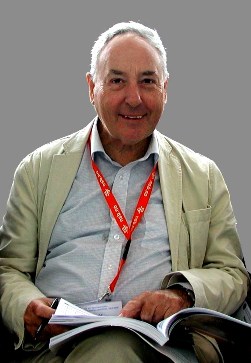 Distinguished English historian of the geological sciences who made his career in New Zealand and Australia.
Distinguished English historian of the geological sciences who made his career in New Zealand and Australia.
The select band who care for the history of our (most historical) science have suffered a grievous loss with David’s death, in Sydney, on 7 November 2014. His multiple skills, whether as author, critic, editor extraordinary, English script-writer, whether from Japlish, Chinglish or Russlish, secretary to INHIGEO, or as a fine cellist, will be impossible to replace.
He was born in Luton, son of Kenneth Oldroyd and Gladys Buckley, on 20 January 1936. He studied sciences at Luton Grammar school (with the initial intention of becoming a doctor). In 1955 he entered Emmanuel College, Cambridge, where there were no places for medicine, so he took natural sciences, migrating from physics to chemistry, while adding the ‘half subject’ geology. He gained a second class, in chemistry, but then found, having been much diverted by too much cello playing, there were no openings for what he most wanted to do, with such a degree. So he first became a school teacher, in Harrow, and married Jane Dawes, whom he had found playing the oboe in our National Youth Orchestra, in 1958.
While teaching, David had started an (evening class) taught master’s degree in history of science at University College, London. In its midst, in 1962, Jane and he decided to emigrate to New Zealand as ‘ten pound poms’, with that government paying their tickets and furniture removal. What a bargain Australasia got! But David still had to find his MSc dissertation topic. He chose Geology in New Zealand prior to 1900, examined, and passed postally, by Victor Eyles (1895-1978). David could now start to think of becoming a university teacher, and having moved to Australia in 1969, soon found a new, history of science, job - teaching at the University of New South Wales (but still with no publications, and no high level teaching experience. Those were the days!).
His PhD on the history of the development of mineralogy in relation to chemistry was awarded in 1974. Australia proved generous with both research leave and expenses, and David managed regular study trips to England. These resulted in his Highlands Controversy book in 1990, and for this, and other classics like his Archaean Controversy series (published in Annals of Science 1991-1995), he was awarded our Society’s Friedman Medal in 1994.
David retired in 1996, to give himself more time to do what he most wanted; and with such success that he was awarded the GSA‘s History of Geology award in 1999, and a Centenary Medal from the Australian Government. He had already been made a fellow of the Australian Academy of the Humanities in 1994, the first historian of science there to be so honoured.
In 1998 came his volume of Variorum Studies published by Ashgate. In 2003 followed his GSL Memoir Earth, Water, Ice and Fire, on the history of geological research in the Lake District (where he had been first sent as a WW2 evacuee). He next proved immensely helpful with our Oxford Dictionary of National Biography, contributing 15 masterful essays when it appeared in 2004.
His last equally remarkable memoir, which appeared after he had been diagnosed with a brain tumour, in 2013, is his extraordinary Maps as pictures: The early development of geological maps (GSA Special Paper 502). This is fine work which will remind us all of his extraordinary skills next year, when we will now be forced to celebrate the bicentenary of William Smith’s equally extraordinary map without him.
Hugh Torrens